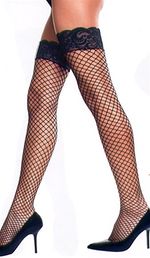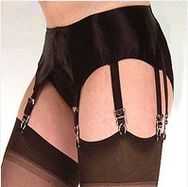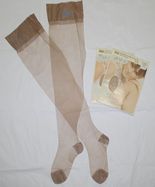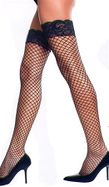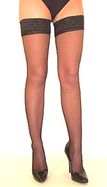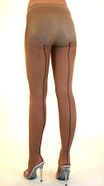Stockings
A stocking is a close-fitting, variously elastic garment covering the foot and lower part of the leg but usually not intended to conceal the leg. The popularity of stockings increases and decreases with fashion. It was formerly made of woven cloth but now of knitted wool, silk, cotton or nylon.
In modern usage, stocking specifically refers to the form of women's hosiery configured as two pieces, one for each leg. The term hold-ups refers to stockings that stay up on their own, while the word stockings is the general term or refers to the kind of stockings that need a suspender belt, and are quite distinct from tights or pantyhose. Thigh highs are often perceived as preferable to pantyhose for various reasons, such as:
- Aesthetics - garters, lace, top fashion, applique, exposure of the thigh, complexity (though it is possible to make tights with fake stocking tops near the top of the legs)
- Easier and quicker access to the genital area - enhances sexual spontaneity
- Message - as more detail is involved, a perception of erotic intent is raised
- Health and cleanliness - less sweat, more ventilation; reduction of fungal and bacterial challenge
- Personal convenience - it is considerably easier and quicker to go to the toilet while wearing stockings
Stockings are typically supported in one of three ways. The most common way is to wear a garter belt (known as a suspender belt in Britain) that goes around the waist and drops extensions (known as suspenders or sussies in England) that are clipped to the tops of the stockings. The second most common means of support is via 'stay-up' technology, where the inside of the top of the stockings has added to it a band (typically silicone) of elastic but highly tractive material that resists slipping down the thigh. This is considerably less reliable in the sense of assuring that the stockings do not fall down, and depends a great deal on the geometry of the actual leg. Further, the elastic can be uncomfortably tight, leaving red marks and possibly aggravating varicose veins. The least common means of support is the circular elastic garter that is slipped up over the top of the stocking and which is intended to hold the stocking by essentially clamping it to the leg. These are the garters typically seen at weddings. They have much the same disadvantages as 'stay-ups'.
In circumstances where the tops of the stockings are visible, some people prefer the look of suspenders. Others feel that hold-ups (aka stay-ups) have less distortion of the top band, an important aesthetic consideration if this band is lacy.
The most convenient (and presently fashionable) way to wear stockings is to wear panties over the stockings and garters. If the panties are reasonably full, this pins the garters to the body, which makes it less obvious exactly what is being worn. (This may be desirable to imbue a sense of mystery.) It also enhances convenience, as going to the bathroom or getting involved in erotic play simply involves pulling down the panties rather than going through all the steps required to detach the garters and re-attach them after the moment has passed. Some do choose to wear panties underneath instead, and it is ultimately a matter of choice.
Modern stockings come in a broad variety of colors and styles.
- Pantyhose
In 1959, pantyhose were invented by Allen Grant, Sr. These consist of both leg coverings woven together with a panty or girdle configured upper section that serves to obviate the entire issue of garters and garter belts. The primary benefit of pantyhose is the convenience of not having to adjust them as much, but there are significant health issues that serve to mitigate the convenience due to the closing off of the groin to ventilation. This problem can be partially mitigated by having a cotton gusset over the groin and by never wearing nylon panties under pantyhose. In the United Kingdom, the same garment goes by the name of tights or occasionally pantyhose (with a slightly different spelling).
Most women find pantyhose or tights far more convenient than stockings. This has led to a sharp decline in stocking wearing, especially since the 1960s, when women started wearing miniskirts; indeed, nowadays stockings are more often worn for their erotic virtues. The invention of hold-ups has led lots of women to wear stockings again. Thus the number of women who wear stockings instead of tights is slightly increasing every year.
- Various forms of stockings
Ancilla Tilia in latex basque and stockings
- Stocking Terminology
- Cuban heel - A stocking with a heel made with folded over and sewn reinforcement.
- Demi-Toe - Stockings that have a reinforced toe with half the coverage on top as on the bottom. This results in a reinforcement that covers only the tip of the toes as opposed to the whole toe. These can be with or without a reinforced heel.
- Denier (measure)|Denier - The lower the denier number the sheerer the garment. Stockings knitted with a higher denier tend to be less sheer but more durable.
- Fishnet - Knitted stockings with a very wide open knit resembling a fish net.
- Fence net - Similar to fishnet, but with a much wider pattern. These are sometimes worn over another pair of stockings or pantyhose, such as matte or opaque, with a contrasting color.
- Full-Fashioned - Full-fashioned stockings are knitted flat, the material is then cut and the two sides are then united by a seam up the back. Full-fashioned stockings were the most popular style until the 1960's.
- Hold-ups or Stay-ups - Stockings that are held up by sewn-in elasticized bands (quite often a wide lace top band).
- Matte - Stockings which have a dull or non-luster finish.
- Mock Seams - A false seam sewn into the back of a seamless stocking.
- Nude Heel - Stockings without reinforcement in the heel area.
- Opaque - Stockings made of yarn which give them a heavier appearance (usually 40 denier or greater).
- RHT - Abbreviation of reinforced heel and toe.
- Sandal foot - Stockings with a nude toe, meaning no heavier yarn in the toe than is in the leg.
- Seamed - Stockings manufactured in the old Full-Fashioned manner with a seam running up the back of the leg. In the past they were manufactured by cutting the fabric and then sewing it together. Today stockings are generally fully knitted and a fake or mock seam is added up the back for a particular fashion look.
- Seamless - Stockings knit in one operation on circular machines (one continuous operation) so that no seaming is required up the back.
- Sheers - Stockings generally of a 15 to 20 denier.
- Knee-Highs - Stockings that terminate at or just barely below the knee.
- Thigh-Highs - Stockings that terminate somewhere in the mid-thigh.
- Ultra Sheer - A fine denier fiber that gives the ultimate in sheerness.
- Welt - A fabric knitted separately and machine-sewn to the top of a stocking. Knit in a heavier denier yarn and folded double to give strength for supporter fastening.
| This article is about Lingerie and undergarments Main article and index is at Lingerie |
| Articles related to feet |
|---|
| Aretifism • Foot • Foot fetishism • Foot torture • Leg worship • Shoe Fetishism • Stocking fetishism • Stockings |
| Portal:Clothing articles |
|---|
|
Chat rooms • What links here • Copyright info • Contact information • Category:Root
